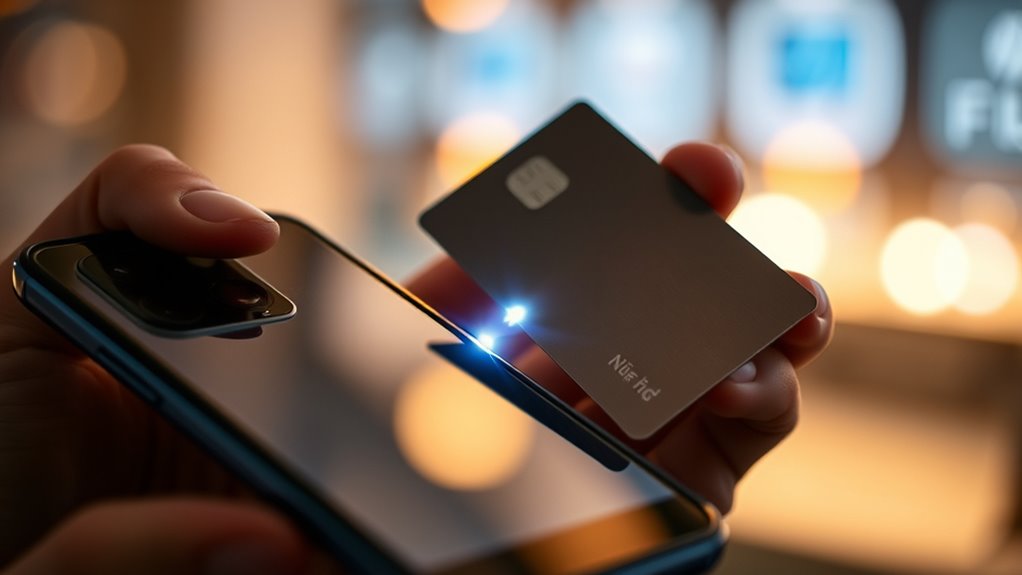NFC technology goes far beyond mobile payments, allowing you to securely share data, pair devices, access secure areas, and even engage with smart advertising. It operates at close range, using electromagnetic fields to transfer information quickly and safely. From easing contactless ticketing in public transit to enabling seamless device connections and secure authentication, NFC’s applications are expanding. To discover how NFC is transforming industries and daily life, stay tuned for more insights.
Key Takeaways
- NFC enables quick, secure data sharing beyond payments, including contact information, URLs, and multimedia files within close proximity.
- It supports device pairing and connections for IoT devices, smart home controls, and wireless peripherals without needing passwords.
- NFC enhances access control and authentication systems, providing secure login, identity verification, and two-factor authentication.
- Industry uses include public transit ticketing, contactless entry, and interactive advertising, transforming passive media into engaging touchpoints.
- NFC’s short-range, low-power technology offers secure, seamless connections across various sectors, extending beyond just mobile payment solutions.
Understanding the Basics of NFC Technology
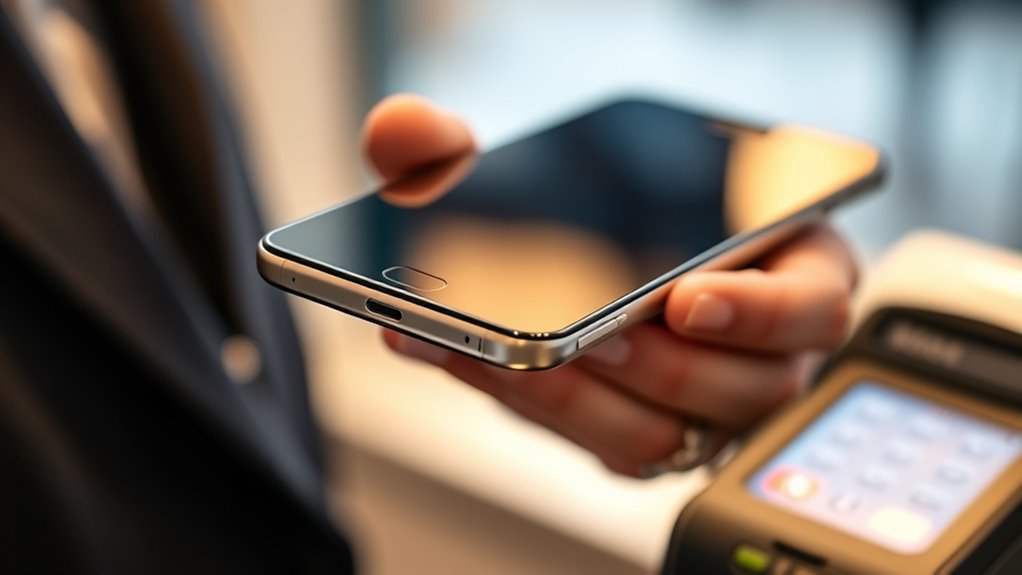
Near-field communication, or NFC, is a short-range wireless technology that enables devices to exchange data quickly and securely. It operates at a frequency of 13.56 MHz within the globally available ISM band. Typically, NFC works over a distance of up to 2 centimeters, sometimes extending to 4 centimeters. This close range guarantees secure communication and minimizes interference. NFC supports data transfer rates from 106 kbit/s to 848 kbit/s, allowing quick exchanges of contacts, URLs, or other information. Many NFC tags are passive, drawing power from the initiating device, so they require no batteries. This technology uses inductive coupling through electromagnetic coils, creating a magnetic field that facilitates data transfer. Its compact design, secure operation, and low power make NFC suitable for a wide range of applications. Because NFC operates at a low power level, it also reduces the risk of explosion risks associated with higher-energy wireless technologies.
Types and Functionality of NFC Tags

NFC tags come in various types, each designed to serve specific functions based on industry standards and application needs. You’ll find five main types: Type 1 through Type 5, each with unique memory capacities, speeds, and features. Type 1 and Type 2 are simple, with small memory—ideal for URLs or contact info—and operate at 106 kbit/s. Type 3, used in Sony’s FeliCa system, offers faster transfer and about 2 kB of memory, perfect for transit cards. Type 4 provides up to 32 kB at speeds up to 424 kbit/s, supporting secure applications like access control. Type 5, based on ISO 15693, offers longer read ranges and larger storage, mainly suited for industrial uses. Your choice depends on your specific needs, balancing data capacity, security, and range. Understanding the different NFC tag types can help you select the most suitable option for your application, especially considering how sound vibrations are believed to influence overall health and cellular regeneration.
NFC in Everyday Consumer Electronics
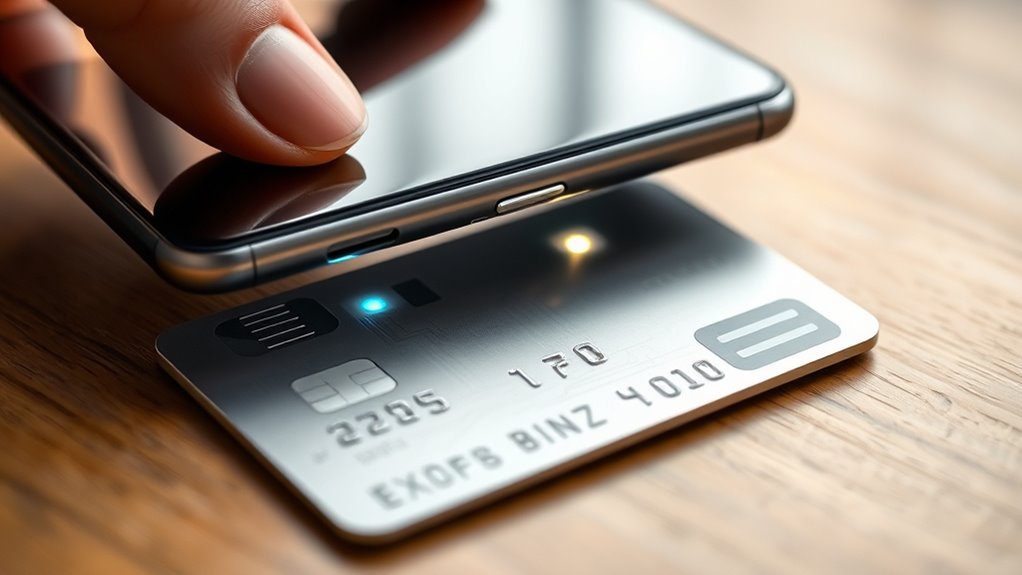
In today’s connected homes, NFC technology simplifies how you interact with your electronic devices. You can effortlessly pair your smartphones with home theater systems, enabling quick control and seamless setup. Wireless headsets connect instantly via NFC, so you don’t waste time on complicated pairing processes. Digital frames and printers become more user-friendly, allowing you to share and print photos directly from your devices with a tap. NFC-enabled speakers offer rapid connectivity, enhancing your listening experience. Smart home devices like smart plugs and lighting systems leverage NFC for easy control and integration, making managing your environment straightforward. NFC also streamlines connecting cameras to your devices for quick image transfers and sharing, reducing hassle and enhancing your everyday interactions with technology.
Applications of NFC in Secure Access and Authentication

Secure access and authentication have increasingly adopted contactless methods, with NFC playing a vital role in enhancing security and user convenience. NFC secure authenticators enable authentication without physical connections, ideal for embedded systems and peripherals. For example, integrated NFC authenticators like Analog Devices’ DeepCover® MAX66250 work with smartphones using ISO 15693 compliance and FIPS crypto libraries, simplifying secure verification. Dedicated NFC reader ICs, such as the MAX66301, can be added to embedded systems, supporting secure authentication independently of smartphones. NFC-based two-factor authentication (2FA) also boosts security by requiring both an NFC token and a passcode, reducing admin overhead and credential theft risks. In enterprise environments, NFC enables seamless, secure login via standardized protocols like FIDO2, improving user convenience while maintaining strict security controls. Additionally, Glycolic acid’s exfoliating properties can be incorporated into skincare routines to support healthy skin alongside NFC-based security solutions. Incorporating personal traits and preferences into security designs can improve user acceptance and overall effectiveness. Furthermore, understanding the individual responses to NFC security methods can help tailor solutions that better meet users’ needs.
Adding to this, ongoing research into skin-related benefits of various skincare ingredients can complement security-focused innovations by promoting overall well-being.
NFC’s Role in Data Sharing and Device Pairing

Building on NFC’s capabilities in secure access, its role in data sharing and device pairing has become increasingly prominent. You can share contacts, URLs, or small files quickly by bringing devices within about 4 centimeters. NFC establishes a peer-to-peer connection, enabling devices to exchange data symmetrically, often initiating transfers that continue over Bluetooth or Wi-Fi. When sharing contacts, you simply tap or bring devices close—on iOS, with NameDrop; on Android, via Android Beam or Nearby Share—after reveal your device for security. NFC also streamlines device pairing, such as connecting Bluetooth headphones or IoT gadgets, by avoiding manual discovery or PIN entry. Its short range and ease of use make NFC a secure, efficient way to share data and connect devices effortlessly. Additionally, contrast ratio plays a crucial role in display quality, ensuring clear images and enhanced viewing experiences. Moreover, understanding privacy and cookies is vital for maintaining user trust and complying with data regulations. Recognizing the importance of security protocols further enhances NFC’s effective and safe application in various environments. Incorporating meditation techniques can also improve user focus and mental clarity during device interactions, promoting a more mindful approach to technology use. Furthermore, product certifications can help users verify the authenticity and quality of NFC-enabled products, ensuring reliable performance.
Enhancing Public Transportation and Ticketing Systems

NFC transforms public transportation by enabling seamless, contactless ticketing that speeds up boarding and reduces queues. You can download tickets remotely onto your smartphone or smart card, avoiding long lines at ticket counters. Tap-and-go NFC validation at barriers accelerates passenger flow, cutting delays and congestion. It’s intuitive, leveraging your familiarity with contactless payments. NFC supports both closed-loop transit cards and open-loop bank cards or wearables, offering flexibility. With NFC, you can use a single device or card across buses, trains, and trams, creating a unified travel experience. It allows door-to-door journey planning by integrating multiple modes. Additionally, NFC tags at stations provide instant access to real-time schedules and alerts, keeping you informed and reducing travel uncertainty. This technology simplifies travel and enhances efficiency for both passengers and operators. Halal-friendly payment options are increasingly integrated into NFC systems, catering to diverse cultural needs. Furthermore, the cultural considerations involved in designing these systems help promote inclusivity and accessibility for all users. Incorporating security features ensures that user data and transactions remain protected, fostering trust in contactless systems. The integration of security measures is crucial to prevent fraud and unauthorized access, maintaining user confidence. Implementing comprehensive privacy and cookie policies helps users understand how their data is managed, building confidence in the technology.
NFC in Smart Advertising and Product Engagement
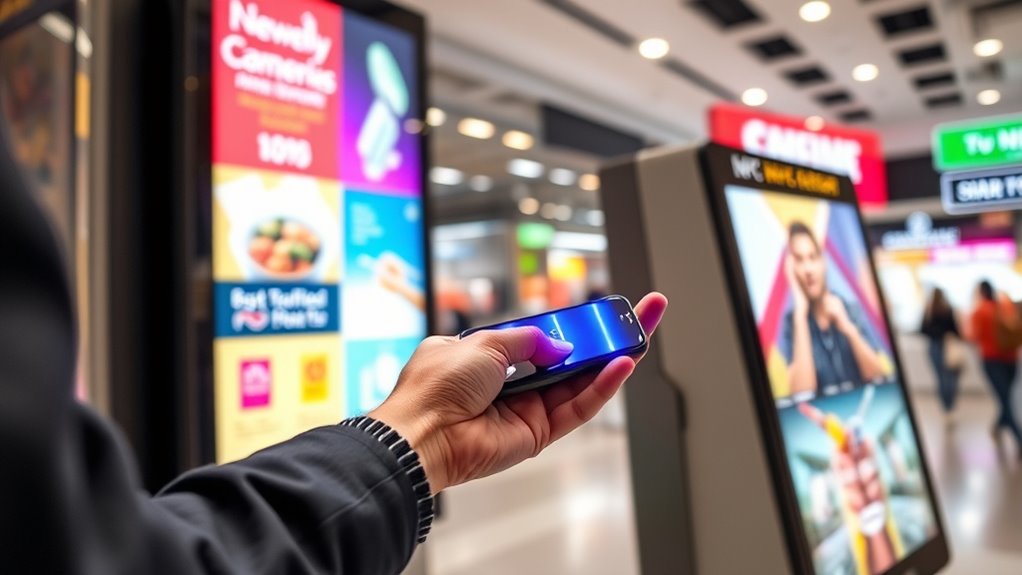
Have you ever noticed how static posters and flyers are becoming more interactive? NFC technology allows you to tap your device and instantly access exclusive content, making advertisements more engaging. Brands embed NFC tags into posters and flyers, seamlessly connecting physical media with digital content like videos, coupons, or product details. This creates a personalized experience, giving you quick access to relevant information and special offers. NFC-enabled packaging also enhances product interaction, providing details on sourcing, usage, or related items at a simple tap. These smart interactions boost brand loyalty and increase conversion rates by transforming passive ads into dynamic, engaging touchpoints. Additionally, leveraging NFC deployment can optimize campaign strategies by analyzing engagement data and improving content relevance over time. Understanding how asset division laws impact the distribution of promotional materials can help companies better tailor their NFC campaigns for different regions. NFC’s affordability and ease of deployment make it an attractive tool for marketers seeking to deepen consumer engagement and deliver targeted, measurable campaigns effortlessly. Incorporating privacy considerations ensures that user data is handled responsibly and builds trust with consumers. Moreover, integrating insights from Personality Exploration can help tailor marketing messages to different consumer segments, enhancing overall engagement and effectiveness.
Security Features and Considerations in NFC Use

The security features of NFC rely heavily on its short communication range, typically limited to about 4 centimeters, which inherently minimizes the risk of remote interception. This close proximity makes unauthorized eavesdropping physically difficult and reduces accidental data exchanges. NFC operates on the 13.56 MHz frequency, supporting secure, short-distance transmissions. Devices use protocols that automatically detect proximity before initiating data transfer, adding an extra layer of security. Cryptographic protections, such as hardware-based encryption via Secure Access Modules, ensure data confidentiality, integrity, and authenticity. Multi-factor authentication like biometrics, combined with tokenization, further safeguards transactions against fraud. Additionally, the use of wall organization systems can help secure physical access to NFC-enabled devices, reducing tampering risks. While risks like eavesdropping, relay, and cloning exist, their practicality is limited due to proximity constraints and encryption, making NFC a secure contactless communication method. Furthermore, ongoing advancements in cybersecurity help address emerging threats and enhance NFC security features.
Industry Trends and Future Potential of NFC Technology
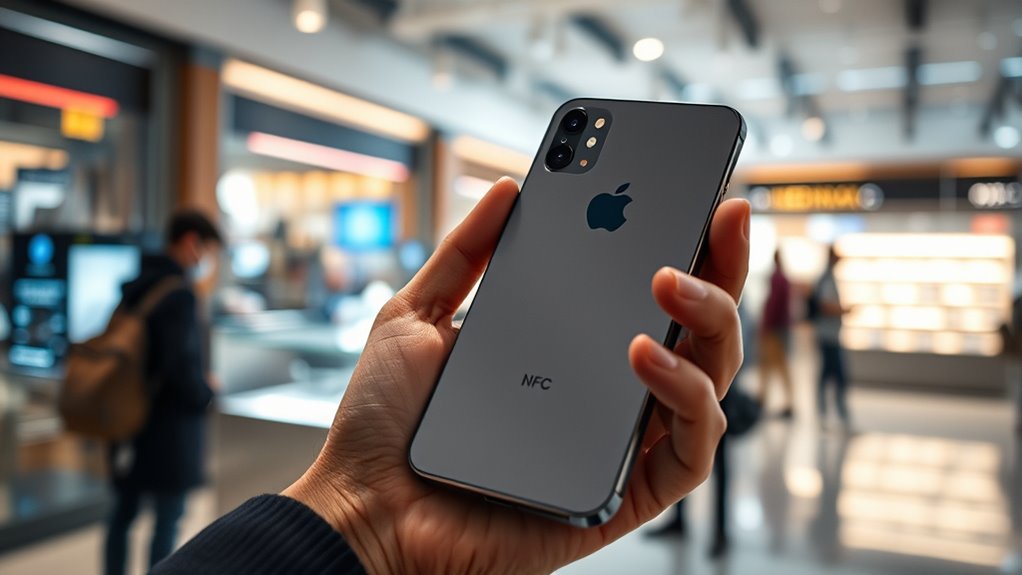
Industry experts anticipate rapid growth in the NFC market, driven by increasing adoption across various sectors such as retail, healthcare, and automotive. The global NFC market is projected to grow from USD 21.69 billion in 2024 to USD 30.55 billion by 2029, with a CAGR of 7.1%. NFC tag ICs will expand from USD 15.6 billion in 2025 to USD 67.2 billion by 2035. Applications like smart public transportation, contactless payments, and NFC rings are gaining traction. Asia-Pacific leads digitalization efforts, holding a significant market share alongside North America. Future prospects include expanding NFC use in digital business cards, IoT integration, and marketing strategies. As technology advances, NFC’s role in seamless, secure connectivity continues to grow across industries.
Frequently Asked Questions
How Does NFC Compare to Other Contactless Communication Technologies Like Bluetooth and RFID?
You’ll notice NFC operates at a very short range, usually within 4 cm, making it more secure for quick exchanges like payments or access control. Compared to RFID, which can work from several meters away, and Bluetooth, which can reach up to 300 meters and transfers data faster, NFC’s main advantage is its simplicity, low power consumption, and higher security for close-proximity interactions.
Can NFC Be Used for Secure Transactions Without Internet Connectivity?
You wonder if NFC can handle secure transactions without internet access. The answer is yes. NFC uses local communication, relying on tokenization, encryption, and biometric authentication to keep transactions safe offline. It supports limited offline payments within predefined limits, especially through contactless cards and mobile wallets. Once connected again, data syncs with the bank or backend systems, ensuring security and accuracy without needing an active internet connection during the transaction.
Are There Privacy Risks Associated With NFC Data Exchange?
You should be aware that NFC data exchange comes with privacy risks. Hackers can intercept or eavesdrop on your NFC communications, potentially stealing sensitive info like credit card numbers or personal details. Unauthorized access, data tampering, and location tracking are also concerns. To protect yourself, use secure devices, keep software updated, enable encryption, and be cautious about sharing information through NFC. Awareness is key to minimizing these risks.
What Are the Limitations of NFC in Terms of Range and Data Transfer?
Think of NFC as a whisper in a crowded room—limited in distance and bandwidth. You’ll find its range is barely a few inches, making it perfect for close encounters but unsuitable for long-distance communication. The data transfer is like passing a note—quick but slow compared to Wi-Fi or Bluetooth. These limitations keep NFC handy for small, secure exchanges but restrict its use for larger or distant data needs.
How Is NFC Technology Evolving to Support New Applications?
You’re curious about how NFC technology is evolving to support new applications. You’ll see advancements like enhanced security with biometric authentication and encryption, making transactions safer. NFC is also integrating with IoT and smart devices for seamless control and communication. Beyond payments, it’s used for ticketing, access control, and data sharing. These developments open exciting opportunities across industries, improving convenience, security, and functionality in your daily interactions with technology.
Conclusion
NFC technology is like a silent handshake connecting your world effortlessly. As you explore its many uses—from secure access to seamless payments—it’s clear that NFC isn’t just a passing trend but a cornerstone of future innovation. Embrace its potential, stay curious, and watch as this tiny chip continues to release big possibilities—turning everyday interactions into simple, secure moments that make life smoother and smarter.
